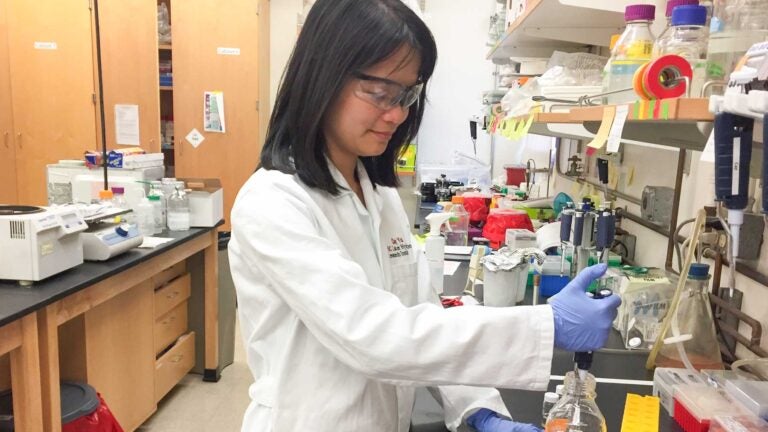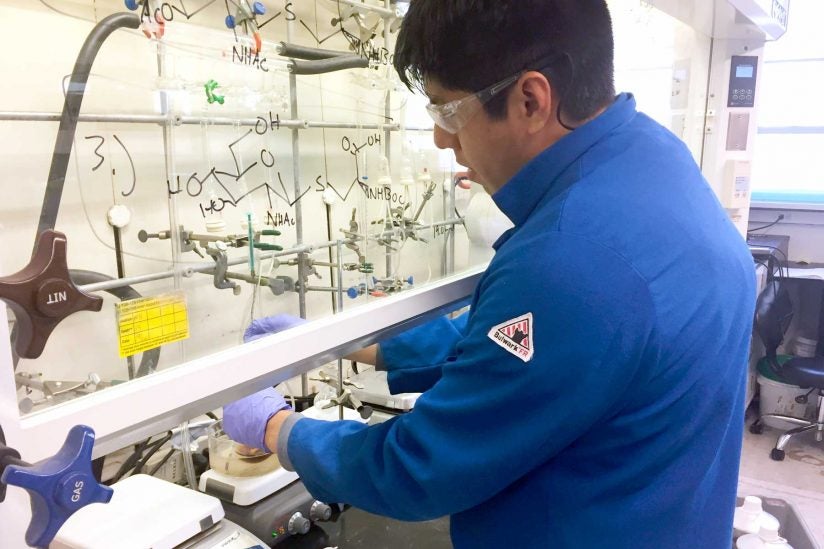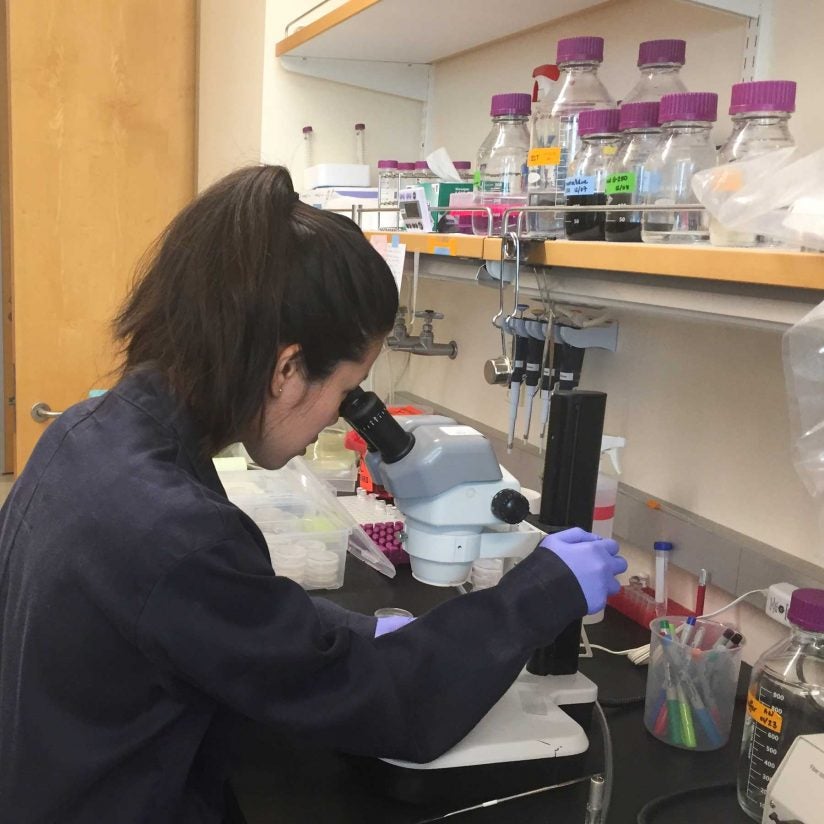
Caiqun Yu works in a lab that offers the opportunity to exchange ideas. (Photo/Rhonda Hillbery)
Training program leads to collaboration among grad students in chemistry and biology
Two-year program aims to build innovative thinkers and solve biological problems
A National Institutes of Health training program that brings about collaboration in the fields of chemistry and molecular biology is giving graduate students new perspectives on both science and future career paths.
“As someone who never studied biology as an undergrad, I’m fascinated by the impact that chemistry can have directly on biology and moving your work toward human innovation,” said Jose Ricardo Moreno, a PhD candidate in chemistry who researches the cellular underpinnings of cancer and other serious diseases.
“As a synthetic chemist, my drive is, how can I synthesize or make new molecules? It wasn’t until biology came into play that I began to see it had a big role to play in finding cures for diseases and finding ways that we can make chemistry a tool to improve the quality of life for human beings. The connection immediately becomes apparent.”
Moreno is one of six PhD trainees supported by a Chemistry and Biology Interface T32 grant, awarded in 2016 by the National Institute of General Medical Sciences.
The two-year program promotes communication across disciplines and builds innovative thinking and approaches for today’s interdisciplinary careers. The new collaboration is all about finding more and better tools to solve biological problems, said program director Susan Forsburg, Gabilan Distinguished Professor in Science and Engineering and professor of biological sciences at the USC Dornsife College of Letters, Arts and Sciences.
Unique identity
What makes the chemical biology sandbox so interesting? The field harnesses chemistry’s quantitative methods of synthesis, analysis and mechanism to make fundamental discoveries that impact human health.
As biologists identify new drug targets using genomic and molecular approaches, there’s a need for chemists grounded in fundamental biology who can design, synthesize, manipulate and characterize molecules. And chemistry provides molecular biologists a deeper understanding of the chemical principles that underlie molecular interactions such as recognition, design, synthesis and reactivity.
“The idea here is that we are trying to create students who have a unique identity as chemical biology students,” Forsburg said. “Trainees identify someone on the opposite program with whom they can have a co-mentor relationship and spend some time in that lab and learn something from the other side.”
Besides venturing into six-week mini sabbaticals, they take several courses in the cross-discipline.
Trainees are schooled in the responsible conduct of research fundamentals. They meet in a weekly journal club to hash over assigned research journal articles and hear prominent lecturers provide overviews of their research. The cadre pores over each paper and asks why is this important and what makes it a good paper? What makes a good research problem? For that matter, what makes a good research program?
Convergent science
The program’s focus on cross-training dovetails with the intensely collaborative direction science evolving at USC, as exemplified in The Bridge@USC. This fall, chemical biologists will be among the prominent researchers from diverse areas across science and engineering who will move into their new home at the USC Michelson Center for Convergent Bioscience.

“Training grants add an extra dimension to graduate education that prospective students seek,” said Stephen Bradforth, USC Dornsife divisional dean for natural sciences and mathematics. “The training program offers professionalization components and opportunities to work in laboratories with multiple investigators that students simply wouldn’t find elsewhere. The fact that USC has received the award underscores the prominence of our chemical biology graduate program as well the excellence of its research faculty.”
USC is one is about 30 U.S. universities awarded training grants in the T32 chemical biology program, and it’s gaining attention.
“It’s been a good tool for us for recruiting top chemical biology program applicants,” said Matthew Pratt, associate professor of chemistry and training grant deputy director.
At his home base in the Pratt research group, Moreno studies glycosylation — the modification of proteins by carbohydrates, how this process helps cancer cells thrive and how it might be disrupted to fight disease.
Now entering his second year as a T32 trainee, Moreno will spend six weeks in the lab of Fabien Pinaud, assistant professor of molecular biology and director of The Single Molecule Biophotonics Group.
“I expect to be taking compounds made in the [Pratt] lab and learning to stain cells and use these compounds to see into the cell,” Moreno said.
He will go very small-scale, using light-based microscopy techniques to detect, study and understand the properties of biomolecules at the cellular, subcellular and molecular levels.
Pathways to understanding
Dieu An Nguyen researches small RNAs (ribonucleic acid) and the mechanisms of their regulatory pathway in nematodes (C. elegans) in the lab of Carolyn Phillips, assistant professor of molecular biology.

Nguyen recognizes that the in vivo lens used to study an intact organism only reveals part of the mystery she is trying to unravel. Chemistry provides a different way of looking at a problem, she said.
“I’m just very excited — a lot of me likes going very in depth in science. But part of me thinks I’m missing out on the larger picture of science. This [program] makes me feel I’m a more comprehensive scientist.”
On the chemistry side, she will be mentored by Professor Lin Chen, working in vitro (in the test tube) to purify worm proteins and study their biochemical properties.
Looking through the lens of chemistry will let her see protein structure and biochemical properties of those proteins with more of an expert eye.
“You can account for much more detail or chemical properties in your biological model than you thought could have done before,” she said. “So the program just sort of opens up this horizon of possible collaborations in the future.”
Pathways to careers
Pratt sees the blossoming field drawing intellectual firepower while also offering attractive career paths for PhDs.
“What they learn allows trainees to come out as full-fledged chemical biologists rather than just a chemist or a biologist,” Pratt said.
He cited the pharmaceutical industry as an eager employer of graduates with a knowledge base that spans both fields.
“A lot of companies are moving in the direction of biological therapeutics,” he said. “For example, there is big growth in therapeutic antibodies, where job candidates need to have good understanding of chemistry and biochemistry, as well as the more biological areas such as exploring protein expression and purification.”
Caiqun Yu primarily works in the lab group of Chao Zhang, assistant professor of chemistry. Her cross-training experience in the lab of Chen, a structural biologist, will allow her to study X-ray protein crystallography, a form of high-resolution microscopy. Investigators believe this tool will ultimately aid in the design of novel inhibitor drugs.
Yu hopes to ultimately work in the pharmaceutical industry.
The year ahead
Now embarking on year two, the training group is developing its own esprit de corps while it prepares to welcome new members.
“I love the people there,” said Caiqun Yu, who primarily works in the lab group of Chao Zhang, assistant professor of chemistry. “We share ideas. We’re also planning on doing a student organized journal club over the summer. I think it’s a good opportunity to continuously talk about science and read papers.”
The National Institutes of Health is providing four slots for 2017-18, when the cohort may grow to 13 first and second-year trainees. The first annual meeting later this year will bring everyone together to celebrate the new collaboration and share results.
